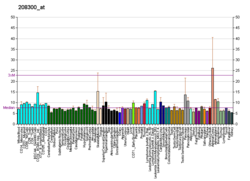Protein-coding gene in the species Homo sapiens
| PTPRH |
|---|
|
| Identifiers |
|---|
| Aliases | PTPRH, R-PTP-H, SAP1, protein tyrosine phosphatase, receptor type H, protein tyrosine phosphatase receptor type H |
|---|
| External IDs | OMIM: 602510; MGI: 3026877; HomoloGene: 37693; GeneCards: PTPRH; OMA:PTPRH - orthologs |
|---|
| Gene location (Human) |
|---|
 | | Chr. | Chromosome 19 (human)[1] |
|---|
| | Band | 19q13.42 | Start | 55,181,247 bp[1] |
|---|
| End | 55,209,506 bp[1] |
|---|
|
| Gene location (Mouse) |
|---|
 | | Chr. | Chromosome 7 (mouse)[2] |
|---|
| | Band | 7|7 A1 | Start | 4,551,611 bp[2] |
|---|
| End | 4,607,040 bp[2] |
|---|
|
| RNA expression pattern |
|---|
| Bgee | | Human | Mouse (ortholog) |
|---|
| Top expressed in | - jejunal mucosa
- duodenum
- pancreatic ductal cell
- mucosa of transverse colon
- gallbladder
- mucosa of ileum
- rectum
- islet of Langerhans
- oocyte
- spleen
|
| | Top expressed in | - jejunum
- ileum
- colon
- duodenum
- stomach
- striatum of neuraxis
- superior frontal gyrus
- cerebellar cortex
- primary visual cortex
- hypothalamus
|
| | More reference expression data |
|
|---|
| BioGPS |  | | More reference expression data |
|
|---|
|
| Gene ontology |
|---|
| Molecular function | - protein tyrosine phosphatase activity
- phosphatase activity
- transmembrane receptor protein tyrosine phosphatase activity
- protein binding
- phosphoprotein phosphatase activity
- hydrolase activity
| | Cellular component | - cytoplasm
- integral component of membrane
- integral component of plasma membrane
- membrane
- plasma membrane
- microvillus
- apical plasma membrane
- microvillus membrane
- cell projection
| | Biological process | - protein dephosphorylation
- dephosphorylation
- apoptotic process
- peptidyl-tyrosine dephosphorylation
| | Sources:Amigo / QuickGO |
|
| Orthologs |
|---|
| Species | Human | Mouse |
|---|
| Entrez | | |
|---|
| Ensembl | | |
|---|
| UniProt | | |
|---|
| RefSeq (mRNA) | | |
|---|
| RefSeq (protein) | | |
|---|
| Location (UCSC) | Chr 19: 55.18 – 55.21 Mb | Chr 7: 4.55 – 4.61 Mb |
|---|
| PubMed search | [3] | [4] |
|---|
|
| Wikidata |
| View/Edit Human | View/Edit Mouse |
|
Receptor-type tyrosine-protein phosphatase H is an enzyme that in humans is encoded by the PTPRH gene.[5][6]
The protein encoded by this gene is a member of the protein tyrosine phosphatase (PTP) family. PTPs are known to be signaling molecules that regulate a variety of cellular processes including cell growth, differentiation, mitotic cycle, and oncogenic transformation. This PTP possesses an extracellular region, a single transmembrane region, and a single intracytoplasmic catalytic domain, and thus represents a receptor-type PTP. The extracellular region contains eight fibronectin type III-like repeats and multiple N-glycosylation sites. The gene was shown to be expressed primarily in brain and liver, and at a lower level in heart and stomach. It was also found to be expressed in several cancer cell lines, but not in the corresponding normal tissues.[6]
References
- ^ a b c GRCh38: Ensembl release 89: ENSG00000080031 – Ensembl, May 2017
- ^ a b c GRCm38: Ensembl release 89: ENSMUSG00000035429 – Ensembl, May 2017
- ^ "Human PubMed Reference:". National Center for Biotechnology Information, U.S. National Library of Medicine.
- ^ "Mouse PubMed Reference:". National Center for Biotechnology Information, U.S. National Library of Medicine.
- ^ Matozaki T, Suzuki T, Uchida T, Inazawa J, Ariyama T, Matsuda K, Horita K, Noguchi H, Mizuno H, Sakamoto C, et al. (Feb 1994). "Molecular cloning of a human transmembrane-type protein tyrosine phosphatase and its expression in gastrointestinal cancers". J Biol Chem. 269 (3): 2075–81. doi:10.1016/S0021-9258(17)42137-5. PMID 8294459.
- ^ a b "Entrez Gene: PTPRH protein tyrosine phosphatase, receptor type, H".
Further reading
- Noguchi T, Tsuda M, Takeda H, et al. (2001). "Inhibition of cell growth and spreading by stomach cancer-associated protein-tyrosine phosphatase-1 (SAP-1) through dephosphorylation of p130cas". J. Biol. Chem. 276 (18): 15216–24. doi:10.1074/jbc.M007208200. PMID 11278335.
- Marneros AG, Mehenni H, Reichenberger E, et al. (2001). "Gene for the human transmembrane-type protein tyrosine phosphatase H (PTPRH): genomic structure, fine-mapping and its exclusion as a candidate for Peutz-Jeghers syndrome". Cytogenet. Cell Genet. 92 (3–4): 213–6. doi:10.1159/000056905. PMID 11435690. S2CID 20187527.
- Takada T, Noguchi T, Inagaki K, et al. (2002). "Induction of apoptosis by stomach cancer-associated protein-tyrosine phosphatase-1". J. Biol. Chem. 277 (37): 34359–66. doi:10.1074/jbc.M206541200. PMID 12101188.
- Strausberg RL, Feingold EA, Grouse LH, et al. (2003). "Generation and initial analysis of more than 15,000 full-length human and mouse cDNA sequences". Proc. Natl. Acad. Sci. U.S.A. 99 (26): 16899–903. Bibcode:2002PNAS...9916899M. doi:10.1073/pnas.242603899. PMC 139241. PMID 12477932.
- Nagano H, Noguchi T, Inagaki K, et al. (2003). "Downregulation of stomach cancer-associated protein tyrosine phosphatase-1 (SAP-1) in advanced human hepatocellular carcinoma". Oncogene. 22 (30): 4656–63. doi:10.1038/sj.onc.1206588. PMID 12879010. S2CID 2707273.
- Pasquali C, Curchod ML, Wälchli S, et al. (2004). "Identification of protein tyrosine phosphatases with specificity for the ligand-activated growth hormone receptor". Mol. Endocrinol. 17 (11): 2228–39. doi:10.1210/me.2003-0011. PMID 12907755.
- Ota T, Suzuki Y, Nishikawa T, et al. (2004). "Complete sequencing and characterization of 21,243 full-length human cDNAs". Nat. Genet. 36 (1): 40–5. doi:10.1038/ng1285. PMID 14702039.
- Beausoleil SA, Jedrychowski M, Schwartz D, et al. (2004). "Large-scale characterization of HeLa cell nuclear phosphoproteins". Proc. Natl. Acad. Sci. U.S.A. 101 (33): 12130–5. Bibcode:2004PNAS..10112130B. doi:10.1073/pnas.0404720101. PMC 514446. PMID 15302935.
 | This article on a gene on human chromosome 19 is a stub. You can help Wikipedia by expanding it. |




















